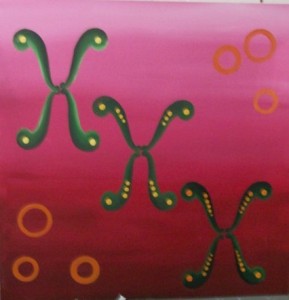Life As An Artist- (Final Feature Story)
December 12, 2012
An artist is often stereotyped in a couple different ways. Some visualize a broke, hippy, getting in touch with their inner feelings, and putting it on a canvas. Others think of fine wine, and arrogant artists in a New York City gallery. However, an artist does not have to be either or. At least not for Shea Hartman-Hodges.
“I knew I wanted to be an artist around the age of 25,” Hodges says. She goes on explaining that, she had lost her job at the bank, had three kids, a husband and had already tried lots of things. She says, “At this point, I didn’t care what I did, I just wanted to enjoy what I did.” Therefore, she began studying at Morningside College, to earn a degree in studio art and creative writing.
Hodges says, “Most people told me I couldn’t get a degree in art or writing. Especially writing, because I have dyslexia. That was all more reason for me to prove them wrong.” Today, Shea sits in her downtown studio in Sioux City. When you meet her, she is happier than ever to talk about anything. Her long brown hair is down, and she is dressed in jeans and a crochet sweater. Her smile she gives is always more than welcoming. Terry McGaffin, a professor at Morningside, says, “I was set up to be her advisor for art classes. She made a strong first impression, a very positive force. Her confidence and self knowledge just leaves you in awe.”
Shea talks about what it means to be a modern day artist. She says, “When I’m asked what I do, and I reply that I’m an artist, they say, ‘OK, but what’s your real job?’” She laughs and says that she usually tells them she also bartends downtown. “People look at art like it’s just a hobby,” explains Hodges. She feels this is why it is so financially hard to keep up. Most people in the area do not buy professional artwork. You can’t buy paint and supplies to continue to do art, when no money from your work is coming in. Other struggles she has found include, finding places to show her work and knowing how to promote herself. “The huge thing I learned in school was confidence and how to take criticism, but no one taught me how to promote myself to the public” she says.
McGaffin feels that one thing Shea does best is keeping herself informed. Sitting on Shea’s desk is a copy of “I’d Rather Be In The Studio,” a book on self-promotion. She looks at it and says that its ‘her bible,’ with a large grin on her face. She does not ever regret her line of work choice. “I love my job. I don’t have to make excuses for being eccentric. Most of all, I can show my kids no matter what, you can go after your dreams,” says Hodges.
Lunatic- 12/6/12
December 6, 2012
I thought this article was kind of funny. It shows how bored lawmakers are, which is why I have to agree with Texas congressman, Louie Gohmert. It is a little crazy to worry about a silly little word like “lunatic,” when being called “crazy” or “insane” can be just as demeaning. We are so worried about hurting peoples’ feelings and being politically correct that we don’t focus on more important issues.
This is a newsworthy story, I guess. It would probably be considered more of a filler story. People like to keep up with whats going on in congress and legislation, but words being banned are not at the top of peoples’ list to read about. This could also be used as a filler broadcast story. It’s short, simple and to the point.
Feature Story- First Draft
December 6, 2012
When you think of an artist, people come to many different conclusions to what an artist is. Some visualize a broke, hippy, getting in touch with their inner feelings and putting it on a canvas. Others think of fine wine, and arrogant artists in a New York City gallery. However, an artist does not have to be either or. At least not for Shea Hartman-Hodges.
Shea is a 32-year old artist, who not only has studied fine art, but has been working as an artist for the last couple years. “There are many struggles with being an artist, especially a painter,” Hodges says, but still she feels it is an amazing career.
Even with the difficulties, Shea still manages to do her artwork, work a second job and raise her family. She feels it’s a constant balancing act, “You want to produce as much art as possible to sell, but you still need a steady income. That’s where bartending comes in for me,” she says.

